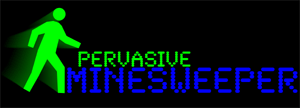|
|
|
Come Out & Play 2006 in New York City
Pervasive Minesweeper takes the classic videogame Minesweeper to the streets! Teams of four individuals race against each other to complete traditional Minesweeper puzzles played out across a 4-square block urban area.
Location: Washington Square Park As with traditional Minesweeper, the goal of Pervasive Minesweeper is to uncover all tiles in the game space that do not have a mine under them. In Pervasive Minesweeper each tile is a city block within a 4-square block area. The tiles ares manipulated by a ShotCode (www.shotcode.com) control panel hidden within each city block. Each playerís ShotCode compatible mobile device is paired with their teamís puzzle to prevent cross-puzzle tampering. Each team is given a clue sheet as to the location of their sixteen control panels. At this point, a timer for the team is started. Once a control panel is located, players may open a tile or flag it as a potential mine. If a tile is opened and it is a mine, that teamís game is over. If there is no mine under the tile, a number is revealed on the teamís xhtml display. The number will tell the team how many mines are touching that tile (left, right, above, and below). When a team has opened all tiles on their game-board that do not contain mines, the team has solved their puzzle and their timer stops. The team that completes their puzzle in the least overall time is named the champion and awarded accordingly. Official Ruleset Play As with traditional Minesweeper, the goal of Pervasive Minesweeper is to uncover all tiles in the game space that do not have a mine under them. In Pervasive Minesweeper each tile is a city block within a 4-square block area. The tiles ares manipulated by a ShotCode (www.shotcode.com) control panel hidden within each city block. Each playerís ShotCode compatible mobile device is paired with their teamís puzzle to prevent cross-puzzle tampering. Each team is given a clue sheet as to the location of their sixteen control panels. At this point, a timer for the team is started. Once a control panel is located, players may open a tile or flag it as a potential mine. If a tile is opened and it is a mine, that teamís game is over. If there is no mine under the tile, a number is revealed on the teamís xhtml display. The number will tell the team how many mines are touching that tile (left, right, above, and below). When a team has opened all tiles on their game-board that do not contain mines, the team has solved their puzzle and their timer stops. The team that completes their puzzle in the least overall time is named the champion and awarded accordingly. The only true rule is that players are forbidden from tampering with other teamís puzzles in any way shape or form. If a player is found to be tampering, his or her team will be disqualified. That being said if a player from Team A discovers on of Team Bís control panels, that information may certainly be bartered between teams. Beyond the basic play mechanics and the non-tamper rules, teams are free to play the game as they wish provided they are not overly disruptive to their surroundings. Designers: Dakota Reese Brown Dakota Reese Brown is currently a Masters Student in Georgia Techís Information Design & Technology program. As part of the Mobile Technologies Group and Experimental Games Lab @ GT, Dakota is active in both pervasive game design and game theory in general. dakota (at) avantgaming dot com |

|